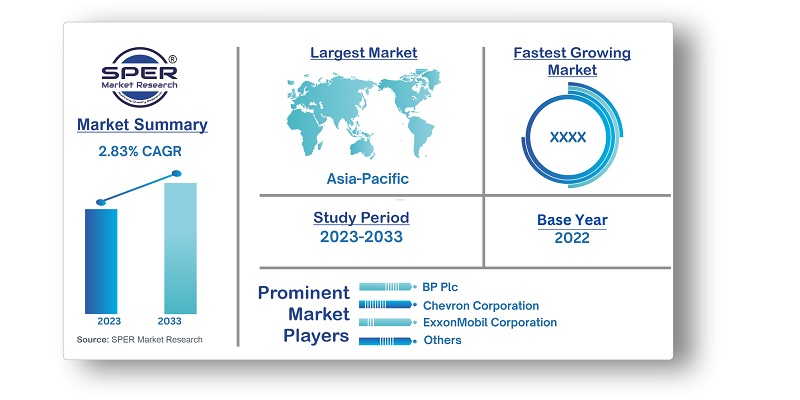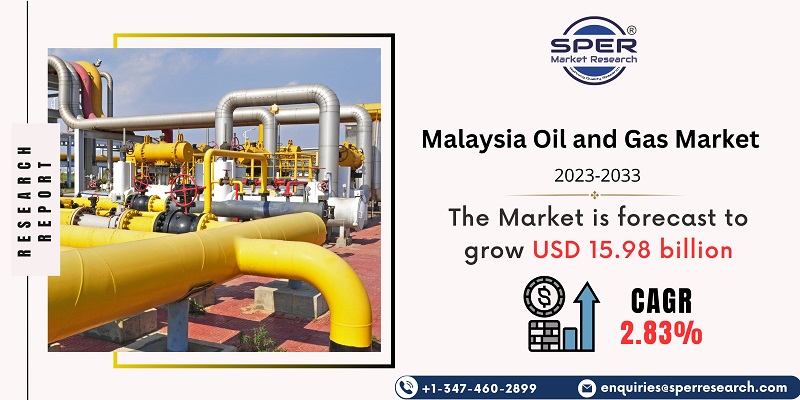
Malaysia Oil and Gas Market Growth, Trends, Share, Size, Revenue, Challenges and Future Outlook
Malaysia Oil and Gas Market Size- By Type - Regional Outlook, Competitive Strategies and Segment Forecast to 2033
| Published: Oct-2023 | Report ID: POAE2363 | Pages: 1 - 105 | Formats*: |
| Category : Power & Energy | |||
- January 2023: JGC Corporation and Samsung Heavy Industries (SHI) formed a consortium to win an engineering, procurement, construction, and commissioning (EPCC) contract from Petronas for the construction of Malaysia's first nearshore floating LNG facility. The proposed plant will be the first nearshore floating LNG facility in the world. It is expected to be finished in 2027 and has a minimum annual production capacity of 2 million tonnes of LNG.
- Petronas announced the finding of oil and gas at the Nahara well in Block SK 306. The block is operated by Petronas Carigali, a wholly owned subsidiary of Petronas, with a 100 percent participating interest in its Production Sharing Contract (PSC).


| Report Metric | Details |
| Market size available for years | 2019-2033 |
| Base year considered | 2022 |
| Forecast period | 2023-2033 |
| Segments covered | By Type |
| Regions covered | Eastern Region, Southern Region, Western Region, Northern Region |
| Companies Covered | BP Plc, Shell Plc, Petronas Gas Bhd, Chevron Corporation, ExxonMobil Corporation, Malaysiaian General Petroleum Corporation, Altus Oil & Gas Malaysia Sdn. Bhd., Petro-Excel Sdn Bhd (PESB), Petro Teguh (M) Sdn. Bhd., and Malaysiaian Natural Gas Holding Company |
- Investors and Shareholders
- Government and Regulators
- Energy and Petrochemical Companies
- Suppliers and Service Providers
- Environmental and Sustainability Advocates
| By Type: |
|
- Malaysia Oil and Gas Market Size (FY’2023-FY’2033)
- Overview of Malaysia Oil and Gas Market
- Segmentation of Malaysia Oil and Gas Market By Type (Transportation, Storage, LNG Terminals)
- Statistical Snap of Malaysia Oil and Gas Market
- Expansion Analysis of Malaysia Oil and Gas Market
- Problems and Obstacles in Malaysia Oil and Gas Market
- Competitive Landscape in the Malaysia Oil and Gas Market
- Impact of COVID-19 and Demonetization on Malaysia Oil and Gas Market
- Details on Current Investment in Malaysia Oil and Gas Market
- Competitive Analysis of Malaysia Oil and Gas Market
- Prominent Players in the Malaysia Oil and Gas Market
- SWOT Analysis of Malaysia Oil and Gas Market
- Malaysia Oil and Gas Market Future Outlook and Projections (FY’2023-FY’2033)
- Recommendations from Analyst
1.1. Scope of the report1.2. Market segment analysis
2.1. Research data source2.1.1. Secondary Data2.1.2. Primary Data2.1.3. SPER’s internal database2.1.4. Premium insight from KOL’s2.2. Market size estimation2.2.1. Top-down and Bottom-up approach2.3. Data triangulation
4.1. Driver, Restraint, Opportunity and Challenges analysis4.1.1. Drivers4.1.2. Restraints4.1.3. Opportunities4.1.4. Challenges4.2. COVID-19 Impacts of the Malaysia Oil and Gas Market
5.1. SWOT Analysis5.1.1. Strengths5.1.2. Weaknesses5.1.3. Opportunities5.1.4. Threats5.2. PESTEL Analysis5.2.1. Political Landscape5.2.2. Economic Landscape5.2.3. Social Landscape5.2.4. Technological Landscape5.2.5. Environmental Landscape5.2.6. Legal Landscape5.3. PORTER’s Five Forces5.3.1. Bargaining power of suppliers5.3.2. Bargaining power of buyers5.3.3. Threat of Substitute5.3.4. Threat of new entrant5.3.5. Competitive rivalry5.4. Heat Map Analysis
6.1. Malaysia Oil and Gas Market Manufacturing Base Distribution, Sales Area, Product Type6.2. Mergers & Acquisitions, Partnerships, Product Launch, and Collaboration in Malaysia Oil and Gas Market
7.1. Malaysia Oil and Gas Market Value Share and Forecast, By Type, 2023-20337.2. Transportation7.3. Storage7.4. LNG Terminals
8.1. Malaysia Oil and Gas Market Size and Market Share
9.1. Malaysia Oil and Gas Market Size and Market Share By Type (2019-2026)9.2. Malaysia Oil and Gas Market Size and Market Share By Type (2027-2033)
10.1. Malaysia Oil and Gas Market Size and Market Share By Region (2019-2026)10.2. Malaysia Oil and Gas Market Size and Market Share By Region (2027-2033)10.3. Eastern Region10.4. Southern Region10.5. Western Region10.6. Norther Region
11.1. BP Plc11.1.1. Company details11.1.2. Financial outlook11.1.3. Product summary11.1.4. Recent developments11.2. Malaysiaian Natural Gas Holding Company11.2.1. Company details11.2.2. Financial outlook11.2.3. Product summary11.2.4. Recent developments11.3. Shell Plc11.3.1. Company details11.3.2. Financial outlook11.3.3. Product summary11.3.4. Recent developments11.4. Petronas Gas Bhd11.4.1. Company details11.4.2. Financial outlook11.4.3. Product summary11.4.4. Recent developments11.5. Chevron Corporation11.5.1. Company details11.5.2. Financial outlook11.5.3. Product summary11.5.4. Recent developments11.6. ExxonMobil Corporation11.6.1. Company details11.6.2. Financial outlook11.6.3. Product summary11.6.4. Recent developments11.7. Malaysiaian General Petroleum Corporation11.7.1. Company details11.7.2. Financial outlook11.7.3. Product summary11.7.4. Recent developments11.8. Altus Oil & Gas Malaysia Sdn. Bhd.11.8.1. Company details11.8.2. Financial outlook11.8.3. Product summary11.8.4. Recent developments11.9. Petro-Excel Sdn Bhd (PESB)11.9.1. Company details11.9.2. Financial outlook11.9.3. Product summary11.9.4. Recent developments11.10. Others
SPER Market Research’s methodology uses great emphasis on primary research to ensure that the market intelligence insights are up to date, reliable and accurate. Primary interviews are done with players involved in each phase of a supply chain to analyze the market forecasting. The secondary research method is used to help you fully understand how the future markets and the spending patterns look likes.
The report is based on in-depth qualitative and quantitative analysis of the Product Market. The quantitative analysis involves the application of various projection and sampling techniques. The qualitative analysis involves primary interviews, surveys, and vendor briefings. The data gathered as a result of these processes are validated through experts opinion. Our research methodology entails an ideal mixture of primary and secondary initiatives.



Frequently Asked Questions About This Report
PLACE AN ORDER
Year End Discount
Sample Report
Pre-Purchase Inquiry
NEED CUSTOMIZATION?
Request CustomizationCALL OR EMAIL US
100% Secure Payment






Related Reports
Our Global Clients
Our data-driven insights have influenced the strategy of 200+ reputed companies across the globe.




















